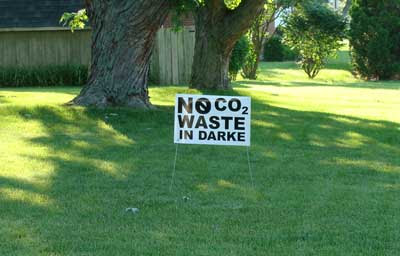NEW HAVEN, W.Va. — Poking out of the ground near the smokestacks of the Mountaineer power plant here are two wells that look much like those that draw natural gas to the surface. But these are about to do something new: inject a power plant’s carbon dioxide into the earth.
A behemoth built in 1980, long before global warming stirred broad concern, Mountaineer is poised to become the world’s first coal-fired power plant to capture and bury some of the carbon dioxide it churns out. The hope is that the gas will stay deep underground for millenniums rather than entering the atmosphere as a heat-trapping pollutant.
The experiment, which the company says could begin in the next few days, is riveting the world’s coal-fired electricity sector, which is under growing pressure to develop technology to capture and store carbon dioxide. Visitors from as far as China and India, which are struggling with their own coal-related pollution, have been trooping through the plant.
The United States still depends on coal-fired plants, many of them built decades ago, to meet half of its electricity needs. Some industry experts argue that retrofitting them could prove far more feasible than building brand new, cleaner ones.
Yet the economic viability of the Mountaineer plant’s new technology, known as carbon capture and sequestration, remains uncertain.
The technology is certain to devour a substantial amount of the plant’s energy output — optimists say 15 percent, and skeptics, 30 percent. Some energy experts argue that it could prove even more expensive than solar or nuclear power.
And as with any new technology, even the engineers are unsure how well it will work: will all of the carbon dioxide stay put?
Environmentalists who oppose coal mining and coal energy of any kind worry that sequestration could simply trade one problem, global warming, for another one, the pollution of water supplies. Should the carbon dioxide mix with water underground and form carbonic acid, they say, it could leach poisonous materials from rock deep underground that could then seep out.
Given the depths to which workers have drilled, they also fret that the project could cause earthquakes, although experts at theEnvironmental Protection Agency discount the risk of catastrophe.
More broadly, some environmentalists argue that the carbon storage effort could give corporations and consumers another excuse to drag their heels in supplanting coal dependence with an embrace of renewable energy sources like the sun and wind.
“Coal is the drug of choice of a major industry with a lot of political power,” said David H. Holtz, executive director of Progress Michigan, an environmental group.
Instead of adopting carbon capture, which Mr. Holtz likens to a methadone cure for addiction, he argues that the industry would do better to go cold turkey.
“There’s no evidence that burying carbon dioxide in the earth is a better strategy than aggressively pursuing other alternatives that clearly are better for the environment and will in the long run be less costly,” Mr. Holtz said.
But power company officials say the effort is the energy industry’s best hope of stanching carbon dioxide emissions over the next few decades.
“I really believe, in my heart of hearts, that coal is going to be burned around the world for years to come,” said Michael Morris, chairman and president of American Electric Power, which owns the plant here. “Retrofitting is going to be essential.”
American Electric Power is the nation’s largest electricity producer, with a coal-fired grid stretching across 11 states.
If all goes smoothly, this week engineers will begin pumping carbon dioxide, converted to a fluid, into a layer of sandstone 7,800 feet below the rolling countryside here and then into a layer of dolomite 400 feet below that.
The liquid will squeeze into tiny pores in the rock, displacing the salty water there, and assume a shape something like a squashed football, 30 to 40 feet high and hundreds of yards long.
American Electric Power’s plan is to inject about 100,000 tons annually for two to five years, about 1.5 percent of Mountaineer’s yearly emissions of carbon dioxide. Should Congress pass a law controlling carbon dioxide emissions and the new technology proves economically feasible, the company says, it could then move to capture as much as 90 percent of the gas.
For now the project consists of the two wells and a small chemical factory. In the factory, smoke diverted from the plant’s chimney is mixed with a chilled ammonia-based chemical. The chemical is then heated, releasing the carbon dioxide, which is pumped deep into the wells.
American Electric Power is spending $73 million on the capture and storage effort, which includes half the cost of the factory. Alstom, the manufacturer of the new equipment, paid for the other half of the factory, hoping to develop expertise that will win it a worldwide market. Alstom would not say what it spent, but public figures indicate that the two companies are jointly spending well over $100 million.
For energy planners, a crucial question is how much this technology would cost if refined and installed on a bigger scale. The answer remains elusive.
Still, many scientists emphasize that Mountaineer is within a dozen miles of four other big coal plants with a combined capacity of 6,000 megawatts, a concentration so great that industry insiders have nicknamed the area Megawatt Alley. If the technology spread to all of them in a cost-effective way, many say, it could have a broad impact on the coal industry.
S. Julio Friedmann, leader of the carbon management program at the Lawrence Livermore National Laboratory in California, calls this corner of the Ohio River Valley a “must win” region for carbon dioxide storage.
Robert Socolow, a Princeton University engineering professor, echoed that sentiment. The nation’s fleet of coal-burning plants “completely dominates our national emissions,” Professor Socolow said.
It is also far easier to corral several million tons flowing from a single chimney than a comparable amount coming from tens of millions of car tailpipes or home heating systems, experts point out.
Far larger projects for capturing and storing carbon dioxide underground have been under way for several years in Europe and North Africa. In North Dakota, the Great Plains Synfuels plant, which converts methane to natural gas, takes the leftover carbon dioxide and pumps it through a pipeline to Canada to stimulate oil production there. But Mountaineer is the world’s first electricity plant to capture and store carbon dioxide.
A state permit issued to American Electric Power limits the pressure it can use to inject carbon dioxide into the rock. This is to reduce the risk that the injection will crack rock layers above that engineers are counting on to keep the carbon dioxide in place.
A nonprofit research group, Battelle Memorial Institute, has installed monitoring wells around the rock that will measure changes in pressure and temperature. Engineers can also send energy pulses through the earth between the wells and measure how fast these travel, as a guide to how the carbon dioxide is spreading.
Asked whether the injections of carbon dioxide could increase the frequency or magnitude of the small earthquakes that are common in the area, an E.P.A. official said it seemed unlikely.
“With proper site selection and good management, we should be able to implement this safely,” said Dina Kruger, director of the agency’s climate change division. Ms. Kruger also emphasized that the carbon dioxide would be monitored to see if it was seeping.
Some local residents are skeptical.
“It doesn’t matter to me if a scientist says it may or may not leak,” said Elisa Young, an anti-coal activist who lives nearby on the Ohio side of the river. “That’s not going to stop it from leaking when push comes to shove.”
At the same time, many others in this coal-dependent region suggest that the notion that carbon dioxide is a menace has been overplayed.
Charles A. Powell, the manager of the Mountaineer plant, who has worked there since it opened three decades ago, pointed out that the gas is given off by every human and animal.
“You are breathing out?” he asked a visitor dryly.






















